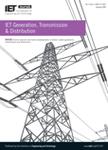版权所有:内蒙古大学图书馆 技术提供:维普资讯• 智图
内蒙古自治区呼和浩特市赛罕区大学西街235号 邮编: 010021

作者机构:Univ Sydney Sch Civil Engn Sydney NSW 2006 Australia Chongqing Univ State Key Lab Power Transmiss Equipment & Syst Se Chongqing Peoples R China Univ New South Wales Sch Elect Engn & Telecommun Sydney NSW Australia Hong Kong Polytech Univ Dept Elect Engn Hong Kong Hong Kong Peoples R China Zhejiang Univ Sch Management Hangzhou Zhejiang Peoples R China
出 版 物:《IET GENERATION TRANSMISSION & DISTRIBUTION》 (IET Gener. Transm. Distrib.)
年 卷 期:2018年第12卷第11期
页 面:2770-2777页
核心收录:
基 金:State Key Laboratory of Power Transmission Equipment & System Security and New Technology (Chongqing University, China) [2007DA10512716401] Faculty of Engineering and Information Technology, University of Sydney, Australia
主 题:renewable energy sources energy management systems tariffs power markets solar power stations power generation scheduling Monte Carlo methods sampling methods probability domestic appliances optimisation cost reduction distributed power generation power generation economics distributed residential energy resource scheduling renewable uncertainty two-way communication technology home energy management system HEMS smart home environment electricity tariff solar power output Monte Carlo sampling technique probabilistic solar radiation model automatically controlled household appliance optimal DRER scheduling model heuristic optimisation algorithm natural aggregation algorithm Australian solar data
摘 要:Advances in metering and two-way communication technologies foster the studies of Home Energy Management System (HEMS). This study proposes a new HEMS, which optimally schedules the distributed residential energy resources (DRERs) in a smart home environment with varying electricity tariff and high solar penetrations. The uncertainties of solar power output are captured by using Monte Carlo sampling technique to generate multiple solar output scenarios based on the probabilistic solar radiation model. The homeowner s rigid and elastic restrictions on the operations of the automatically controlled household appliances are modelled. Based on this, an optimal DRER scheduling model is proposed to minimise the home operation cost while taking into account the homeowner s requirements. A new heuristic optimisation algorithm recently proposed by the authors, i.e. natural aggregation algorithm, is used to solve the proposed model. Simulations based on real Australian solar data are conducted to validate the proposed method.